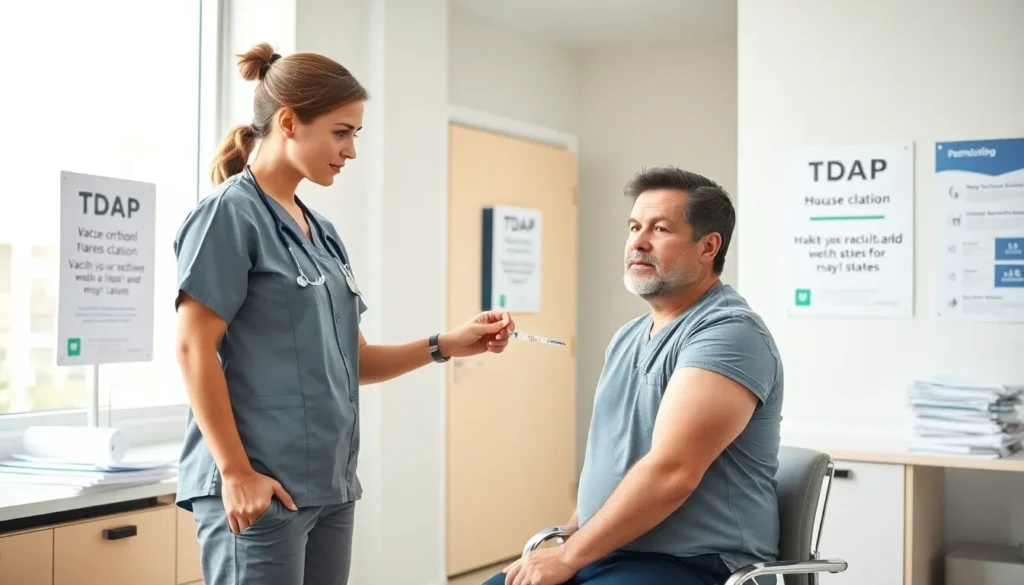Imagine you’re a superhero, but instead of a cape, you wear a tiny band-aid. Spoiler alert: That band-aid is all about the Tdap vaccination. It’s like your shield against three nasty roadblocks: tetanus, diphtheria, and pertussis. This article breaks down the ins and outs of the Tdap vaccine, ensuring you’re armed with all the info you need to keep you and your loved ones protected. So, let’s jump into the world of vaccinations, don’t worry, no needles yet.
Table of Contents
ToggleUnderstanding Tdap: The Basics

The Tdap vaccine stands for Tetanus, Diphtheria, and Pertussis. It’s a combination vaccine designed to protect individuals from these three potentially serious diseases. Tetanus, often called lockjaw, can lead to muscle stiffness and spasms. Diphtheria can cause throat swelling, making breathing difficult. Pertussis, or whooping cough, is particularly dangerous for infants, leading to severe coughing fits that can be life-threatening. By receiving the Tdap vaccination, individuals are investing in their health and the health of those around them, especially vulnerable populations.
Immunization against these diseases is especially crucial since these infections can re-emerge if vaccination rates decline. Tdap is usually given in adolescents and adults to boost immunity after the initial childhood vaccines. Understanding what the vaccines protect against helps individuals appreciate the importance of keeping vaccinations up to date.
The Importance of Tdap Vaccination
The importance of the Tdap vaccine cannot be understated. By vaccinating against tetanus, diphtheria, and pertussis, communities gain a collective shield, reducing the risk of outbreaks. In 2020, for instance, an uptick in pertussis cases drew attention to how easily these diseases can resurge if vaccination coverage falls.
Also, the vaccine’s role extends beyond just individual protection. Vaccinating a large percentage of the population contributes to herd immunity, which protects those who cannot be vaccinated, like newborns or individuals with specific health conditions. In other words, getting vaccinated isn’t just about personal health: it’s about community health. This interconnectedness highlights the need for maintaining high vaccination rates.
Who Should Get the Tdap Vaccine?
Tdap vaccination is recommended for a variety of groups. Primarily, adolescents typically receive a dose between ages 11 and 12, serving as a booster after their initial vaccinations given in childhood. Adults should get a Tdap booster every ten years to maintain immunity.
Expectant mothers are also strongly advised to receive the Tdap vaccine during their third trimester. This timing helps protect the newborn from pertussis before they can be vaccinated themselves. Also, caregivers and anyone who will be in close contact with infants should be vaccinated to minimize transmission risks. In essence, the Tdap vaccine is for anyone who values their health and the health of those around them.
Tdap Vaccine Schedule and Dosage
The Tdap vaccine schedule involves specific age recommendations and dosage timing. The initial dose is generally given to children at 2 months, followed by additional doses at 4 months and 6 months. After this initial series, a booster is provided between ages 11 and 12. For adults, a single Tdap booster is recommended every ten years.
Benefits and Potential Side Effects
Receiving the Tdap vaccination comes with a host of benefits. Primarily, it dramatically reduces the risk of contracting tetanus, diphtheria, and pertussis. The vaccine is effective in building immunity, helping to protect individuals and their communities from outbreaks.
But, like all vaccinations, the Tdap vaccine can have side effects. Most individuals experience mild reactions such as soreness at the injection site, tiredness, or mild fever. In rare cases, more severe allergic reactions may occur, but these are uncommon. Overall, the benefits of vaccination far outweigh the risks associated with potential side effects.
Where to Get Tdap Vaccination
Finding a provider for the Tdap vaccination is often easy. Many clinics, pharmacies, and even pediatricians administer the vaccine. Checking local health departments can also provide information about accessibility and availability. Some work environments may require proof of vaccination, so keeping medical records handy is a smart move. Online resources, including the CDC and local health department websites, often list participating providers and vaccination events, making it even easier for individuals to stay up to date.










